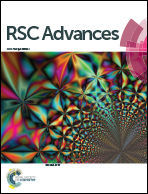Quantitative analysis of five toxic alkaloids in Aconitum pendulum using ultra-performance convergence chromatography (UPC2) coupled with mass spectrometry†
Abstract
A rapid and efficient ultra-performance convergence chromatography (UPC2) method coupled with electrospray ionization single quadrupole mass spectrometry (ESI-MS) was developed and validated for the simultaneous quantification of five diester diterpenoid alkaloid constituents (3-acetylaconitine, hypaconitine, deoxyaconitine, mesaconitine, aconitine) in Aconitum pendulum. Optimum separation was achieved on a BEH 2-EP C18 column (2.1 × 150 mm i.d., 1.7 μm particle) with a gradient elution of a mixture of A (supercritical CO2) and B (methanol containing 10 mmol L−1 ammonium acetate) and at a flow rate of 0.8 mL min−1 within 3 minutes. Quantification was performed using mass spectrometry in a positive ion ionization mode and selected ion recording (SIR) mode. The influences of column, modifier, additive, column temperature, and back pressure were investigated. The five alkaloids were identified and quantified using a comparison of retention time, ultraviolet spectrum, molecular ion peak (obtained from a selective ion recording mode) and peak areas with the reference compounds. The method was validated through linearity, limits of detection, limits of quantification, precision, stability, repeatability, and accuracy. The validated method was applied to analyze A. pendulum, which provided a reference for the quality evaluation of A. pendulum.


 Please wait while we load your content...
Please wait while we load your content...